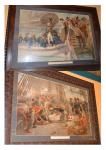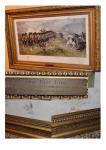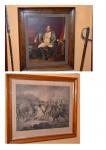-
Posts
48 -
Joined
-
Last visited
-
Days Won
1
Cathey last won the day on July 3 2011
Cathey had the most liked content!
Profile Information
-
Location
Australia
Cathey's Achievements
-
Brass hilted Highland Officer’s Basket Hilt Pattern 1798 Overall Length: 94.8 cm (37.3 inches) Blade length: 80.6 cm (31.7 inches) Blade widest point: 2.985 cm (1.2 inches) Hilt widest point: 13.4 cm (5.3 inches) Inside grip length: 10.3 cm (4.1 inches) Marks, etc: Marked with a crown GR DRURY, stamped near the hilt are the letters EC with 6 small stars. The stars appear to have been applied to strike out other letters. These letters look like R.I.I.J.I.R? Description 1798 Pattern Highland infantry officer's backsword; the type carried by Scottish infantry regiments during the Peninsula War and Battle of Waterloo against Napoleon's forces. The single fullered blade is marked with a crown GR DRURY, stamped near the hilt are the letters EC with 6 small stars. The hilt is brass hilt is constructed of solid plain panels and has remnants of past gilding. The grip is fish skin with brass wire. These are usually seen with broad sword blades, however this is a backsword. The 1798 Pattern was the first attempt by the British to standardize sword patterns for the Scottish regiments and was very loose in some respects, with blades coming from Solingen (Prussia / Germany), England and Scotland, clearly with officers mounting the blades from their existing pre-pattern swords. The brass hilt is fundamentally weaker than steel hilts, hence the pattern is rare as the hilts suffered terribly over time. Cheers Cathey & Rex
-
HEAVY CAVALRY OFFICER’S UNDRESS SWORD Circa 1796-1821 English hilt, German Blade Overall Length: 104.3 cm in scabbard (41.1 inches) 101 Sword only (39.8 inches) Blade length: 87.3 cm (34.4 inches) Blade widest point: 3.7 cm (1.5 inches) Hilt widest point: 12.4 cm (4.9 inches) Inside grip length: 11.5 cm, (4.5 inches) 17 turns of wire binding around the grip Marks, etc: Steel scabbard bares the names Woolley & Deakin. Blade signed near hilt J. J. Runkel Solingen Description: Pattern 1796 Ladder Hilt Heavy Cavalry undress officers sword, has a broad long single-edged blade with a hatchet point and the guard is an open work steel bowl decorated with scrolls in the form of the petals of the honeysuckle flower. Very good Condition, scabbard bares the name Woolley & Deakin. The blade is German marked faintly J. J. Runkel Solingen. This sword is described by Ffoulkes & Hopkinson, Sword, Lance and Bayonet and Wilkinson-Latham, British Cut and thrust weapons as having been developed in 1834. Robson, Swords of the British Army does not agree and maintains that this hilt was introduced in 1796 and remained the regulation for heavy cavalry officers until 1821. General Remarks Blade made by J. J. Runkel – Solingen, Prussia 1780-1800. Many of his blades were hilted to become Highland broadswords of Scotland. Waterloo Sword Collector Haydn Vesty: 1796 Pattern Ladder Hilt Officers Undress, probably late make but no later than 1810. References: Bonhams, 1/4/04 Lot 322 pp100 BULL, S. European Swords Shire 298 Album. Pp22. DUFTY, A. European Swords & Daggers in the Tower of London. pp 31, plate 81,d ROBSON, B. Swords of the British Army pp 85, plate 65,90,128, plate 110. SOUTHWICK, L The Price Guide to Antique Edged Weapons pp 125. plates 330,332 WILKINSON-LATHAM, J. British cut and thrust weapons. Pp 15, plates 9. WILKINSON, F. Edged Weapons. Pp 148.
-
Hi Jonathan, Your right is should be 19th or late 18th, without a maker it is impossible to pin point. What are your thoughts on the possible Scottish connection? it was only recently I noticed the Scottish thistles on the blade. Cheers Cathey
-
BLACK WATCH BASKET-HILT Date: Circa 1750-70 (18th Century) Scottish Black Watch 42nd Highland Regiment Overall Length: 96.8 cm (38.1 inches) Blade length: 82.8 cm (32.6 inches) Blade widest point: 3.5 cm (1.4 inches) fuller runs 63.9 cm (25.2 inches) Hilt widest point: 16 cm (6.3 inches) Inside grip length: 12 cm (4.7 inches) Marks, etc: Nil Description: English Black Watch basket-hilted backsword for highland regiments (42nd Royal Highland Regiment), c1750-70. Straight single edged fullered blade. Although unmarked the hilt pattern suggests the Maker to be Jeffrey’s of London. Regulation Jefferys hilt, panels pierced with triangular darted and circular openings, line engravings included in panel decoration. The three branches of the guard are riveted to a ring which fits around the truncated conical pommel with spherical button, leather grip wire missing. General Remarks: Slight differences in Guard construction indicates this sword was supplied by Nathaniel Jeffery’s London. No maker, retailer or Military marks found. It is not until 1759 that a supplier of swords can be identified in documentation: Nathaniel Jefferys of London. In October of that year he delivered 3500 “Broad swords with iron baskets and paste-board scabbards” at five shillings each to the Board of Ordinance. The London trade directories record a Nathaniel Jefferys, goldsmith, located at 32 Strand, corner of Villiers Street, from c 1768-1779. After this date, Jefferys was succeeded by the firm of Dru Drury & Son but it appears that Drury and Jefferys had been in some kind of partnership since around 1770 as the directories record Dru Drury at the same address from that year. References: BEZDEK, Richard H. SWORDS AND SWORD MAKERS OF ENGLAND AND SCOTLAND Pp341 DARLING, Anthony D. SWORDS FOR THE HIGHLAND REGIMENTS 1757 - 1784 published by Andrew Moebray Inc pp13. Wallis & Wallis Connoisseur Auction Autumn 2001 9-10/10/2001 Lot 100
-
Hi Mervyn, Stuart said you wanted me to post some more swords, here is the first one. Looking forward to chatting on Skype Saturday. Date: Pattern 1796 (18th Century) This sword probably produced in early 19th but who really knows. Overall Length: 87 cm (34.3 inches) in scabbard, 83.7 cm (33 inches )sword only Blade length: 72.6 cm (28.6 inches) Blade widest point: 3.286 cm (1.3 inches) Hilt widest point: 14 cm (5.5 inches) Inside grip length: 8.9 cm (3.5 inches) Marks, etc: Initials TRBC, Blue and gilt decoration crowned post 1801 Royal Arms, the crowned Royal GR cypher and foliage including Scottish Thistles. Description: Georgian 1796 Pattern Light Cavalry Officer's Blue & Gilt Sword Curved blade double-edged towards the tip, blue and gilt decoration covering three-quarters of its length, crowned post 1801 Royal Arms, the crowned Royal GR cypher and foliage including Scottish Thistles. Steel stirrup hilt including a pair of langets with faceted borders, knuckle guard and back-strap each decorated with a pair of vertical notched bands, original fishskin-covered grip bound with twisted silver wire, and the hilt retaining traces of an early silvered finish, in its leather scabbard with shaped steel mounts engraved with linear ornament, and engraved with the owner's initial 'TRBC'. General Remarks Post 1801 arms, May not be cavalry, it has been suggested that it might be Rifles. Initials TRBC, could be JRBC, difficult to be sure. The presence of Scottish thistles in the decoration may indicate the sword was made for a Scottish officer possibly Yeomanry or Militia (Volunteers). Cheers Cathey and Rex
-

RARE HISTORICAL MILITARIA PRINTS
Cathey replied to Mervyn Mitton's topic in Great Britain: Research, Documentation & History
Hi Mervyn Here are the two Nelson prints you asked for. The first one has the title “Good-bye, my Lads!” Nelson leaving Portmouth to Sail for Trafalgar on the Victory.” The second print is titled “The Hero of Trafalgar” Nelson on Board the Victory October 21st 1805”. Cheers Cathey and Rex -

RARE HISTORICAL MILITARIA PRINTS
Cathey replied to Mervyn Mitton's topic in Great Britain: Research, Documentation & History
Hi Mervyn Here is the Thin Red Line. This one is an artist’s proof with a pencil drawing of one of the character’s in the corner and a brass plate reading “The Thin Red Lin 93rd Highlanders Repulsing Russian Cavalry Balaklava, 25th October 1854”. This print is by Robert Gibb 1881 and signed by the artist in pencil. I will post the Nelson Prints next. Cheers Cathey and Rex -

Uniform ID
Cathey replied to Stuart Bates's topic in Great Britain: Militaria: Badges, Uniforms & Equipment
Hi Stuart A nice piece of detective work Stuart or should I say Sherlock Cheers Rex -

RARE HISTORICAL MILITARIA PRINTS
Cathey replied to Mervyn Mitton's topic in Great Britain: Research, Documentation & History
Hi Guys as you can see we are keen on military prints, if you want close ups of any of these let us know and we will try. Cheers Rex -

RARE HISTORICAL MILITARIA PRINTS
Cathey replied to Mervyn Mitton's topic in Great Britain: Research, Documentation & History
Hi guys Large Oil Painting of a young Napoleon by myself, based on a combination of various old prints and including Napoleons coat of arms. I had intended to do a matching Wellington, but I am extremely time poor. Cheers Cathey -

RARE HISTORICAL MILITARIA PRINTS
Cathey replied to Mervyn Mitton's topic in Great Britain: Research, Documentation & History
Hi sorry about the delay in posting prints, but Rex does not know how to post and has to wait for me to help him. The first print is Napoleon looking very dejected, no artists names present, the second is call Napoleon and his Generals. Cheers Cathey and Rex -
Medals-James Stott (Gordon Highlanders and Cameron Highlanders) The items in this group came from the estate of James Scott and consist of a large silk picture dedicated to the Gordon Highlanders, Gordon Highlander silver shooting medal, Gordon Highlander Queen’s South Africa Medal 1899 with four bars. Gordon Highlander King’s South Africa Medal 1902. Cameron Highlander 1914-15 Star. Cameron Highlander 1914-20 British War Medal. Cameron Highlander Victory Medal 1914-19. Corp of Commissionaires Medal. Gordon Highlanders - Rank Private to Sergeant in Boer War Queen’s South Africa Medal, Service No: 3434 Pte J Stott GORDON HIGHS. Date: 1899. Campaign: Anglo-Boer War 1899-1902. 4 Clasps Belfast, Laing’s Nek, defence of ladysmith & Elandslaagte. King’s South Africa Medal, Service No: 3434 Serjt’s J Stott GORDON HIGHS Date: 1902. Campaign: South Africa 1901- Shooting Medal Silver SGTS SHIELD SHOOTING COMPETITION 2ND SERGT J STOTT 1909 Cameron Highlanders - Rank Sergeant to Acting Warrant Officer Class 2 WW1 1914-15 Star, Service No: 1511 C.O.M SJT J Stott Camerons Date: 1918. Campaign: First World War 1914-15. 1914-20 British War Medal Date 1919, Campaign: First World War, 1914-20. Date: 1919. Campaign: First World War, 1914-20. Victory Medal 1914-19 Date: 1919. Campaign: First World War 1914-19. Corp of Commissionaires Medal, ribbon red, white & Blue, Metal Silver. Size 40mm. Description: A 16 point star bearing a central medallion with the Union Jack in the centre surrounded by the Latin mottoes: VIRTUTE ET INDUSTRIA (Top) and LABOR VINCIT OMNIA (Foot – “by valour and industry” and “work conquers all” respectively. Comments: Awarded by the Corps of Commissionaires for long and exemplary service.
-
London Scottish, can anyone help? The London Scottish Museum in the UK has no record of an officer with the initials PHHB, however the engraved initials do not appear to have been added latter as is often the case with Scottish swords. I have checked through my Harts and Arms list with no joy. The sword turned up in America so I am wondering if there was a branch of the London Scottish there, I am at a loss to identify this chap and any help will be gratefully received. Pattern 1828 Officers Basket Hilted Sword to London Scottish Date: Circa 1987-1902(19th Century) Overall Length: 102 cm (40.2 inches) Blade length: 82.6 cm (32.5 inches) Blade widest point: 3 cm (1.2 inches) Marks, etc.: Imperial Crown, Owner's Initials. PHHB Description This is a Scottish regimental basket hilt for the London Scottish Volunteers, and has the original owner's initials on the blade. The sword has a crack in one bar, other wise it is complete, and tight, in its original scabbard. The guard and scabbard are nickled, with no losses at all except on the ball at the tip of the scabbard, which is dented from carrying. There are minor flecks on the scabbard. The grip is fine grey sharkskin with triple wire wrap. The silk tassel is present, as is the basket liner. The ribbon that edges the liner is tattered. The double edged blade has the Imperial crown over Queen Victoria's cipher, which dates this between 1897 and 1902. The other side of the blade has the Imperial crown over London Scottish Volunteers. Below that are the owner's initials: PHHB. The blade is also etched with panoplies of thistles. The proof mark is a crown over "PROVED." Cheers Cathey and Rex







